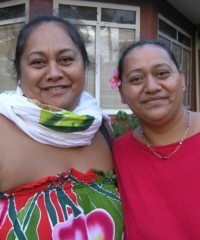Rapa Nui, Easter Islander in Chile

Photo Source:
Anonymous
|
Send Joshua Project a map of this people group.
|
| People Name: | Rapa Nui, Easter Islander |
| Country: | Chile |
| 10/40 Window: | No |
| Population: | 9,300 |
| World Population: | 9,300 |
| Primary Language: | Rapa Nui |
| Primary Religion: | Christianity |
| Christian Adherents: | 85.00 % |
| Evangelicals: | 9.00 % |
| Scripture: | New Testament |
| Ministry Resources: | Yes |
| Jesus Film: | No |
| Audio Recordings: | No |
| People Cluster: | Polynesian |
| Affinity Bloc: | Pacific Islanders |
| Progress Level: |
|
Introduction / History
The Rapa Nui people are Polynesians, such as Hawaiians, Tahitians, and the Maori of New Zealand. The native languages of these islands are very similar. The island is today part of Chile, and strong South American influences threaten the existence of the fragile Rapa Nui culture.
What Are Their Lives Like?
As tourism became a more common part of Easter Island society since the 1990s, and people travel from all over the world to see this unique culture, there has been an increased pride in the cultural Rapa Nui identity.
Today, most newborns that are Rapa Nui are given Rapa Nui names, and parents try to speak the native language to their children as much as possible. During the 1980s and before, most babies were given Spanish names, and parents often made an effort to teach their children Spanish, even if this was their weaker language.
Over the past decade, Rapa Nui activists have been fighting for self-determination and sovereignty over their lands. Protests in 2010 and 2011 by the Indigenous Rapa Nui on Easter Island, objecting to the creation of a marine park and reserve, have led to clashes with Chilean police.
Music, dance, and art have always been a central part of Rapa Nui culture. Some of their renowned dances are the Sau Sau, originally from Samoa, but now represents Eastern Island; the harmonic Ula-Ula; the acrobatic Tamuré, the playful Kai-Kai song.
Their lives are linked to nature and the sea. Fishing, agriculture and the recollection of fruits are the fundamental activities that have nourished the community throughout the years and have preserved the unity of these people.
What Are Their Beliefs?
They believe that the spirit of their ancestors can help them if needed, as the soul (mana) wanders close to their relatives before leaving this dimension forever.
They pay homage to the past generation, and this practice led to the most characteristic representation in Easter Island known as the moais, which were sculptures made of stone representing important people. Then, the sculpture was set on a ceremony altar where they put a hat and a pair of eyes made of red slag.
What Are Their Needs?
The distance between Easter Island and the continent is so complicated that the Chilean government pays attention to the Rapa Nui people's needs. Therefore, they frequently face economic problems, as well as some exploitation of their culture by tourist companies, who take advantage of their culture and traditions to make money at their expense.
They need to be independent and manage their own resources instead of waiting for political resolutions to give them the infrastructure to maintain their territory and keep it safe.
Prayer Points
Pray that the Rapa Nui people have decent living conditions.
Pray that the natural resources of the island are respected and that the community not be exploited by foreigners or the Chilean government.
Pray that they become independent so they can manage their own resources.
Pray that churches in Chile open their hearts and support Rapa Nui financially and spiritually, complying with the call of Jesus in Matthew 28:19-20.